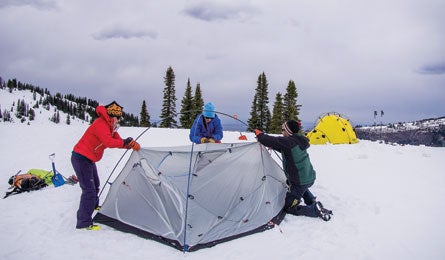Winter Survival Guide: Camp

'Tent setup (B. Fullerton)'
Winterize Your Campsite
Follow these steps to create a comfortable overnight spot.
>> Look up. “Make sure there are no widowmakers nearby,” says Ben Shillington, author of Winter Backpacking and an expedition guide based in Ontario, Canada. “Frozen, brittle sap makes dead trees more prone to breaking and falling.”
>> Stomp out a level tent platform with your snowshoes. Give it at least an hour to sinter (refreeze and set solid), and keep your snowshoes on that entire time so you don’t create an uncomfortable posthole where the tent will be, says Shillington.
>> Pack down a potty trail. It should lead to a sheltered area 150 to 200 yards away from the tent and cooking zones, and away from water sources and main trails.
>> Pitch your tent. “Use your snowshoes, shovel parts, or skis like you’d use deadmen, tying your guylines around them. They’re secure, and you won’t have to pack stakes,” Shillington says. Also, face the front door downhill and away from prevailing winds.
>> Use a single door. Plan to cook and organize gear in one of your tent’s vestibules, and use the other side to climb in and out, which will minimize tracked-in snow.
>> Build snow walls around the tent to block wind. The most wind-protected area will be away from the barrier a distance equivalent to five times the wall’s height.
>> Enjoy and explore. After dinner, take a night hike. “The stars are amazing—plus, if you go to bed warm from the exercise, you’ll sleep better,” says Shillington.
Build a Heat Bomb
“Fill a bottle with hot water before bed and put it in the foot of your sleeping bag so it will be cozy when you crawl in. Around camp, you can also tuck one into your jacket; it’ll stay warm for several hours.”
–K. Cordes
Go to Bed on Empty
“Try to pee a lot before settling in for the night. Having a full bladder makes your body work harder to stay warm, so you feel colder. The extra trips will also reassure you that you’re staying hydrated. In case I do have to go at night, I keep a pee bottle—tightly sealed!—in the tent so I don’t have to go outside.”
–Shannon Davis, Climbing Editor
Sleep Soundly
“A good night’s sleep gives you the best chance for success the next day,” Shillington says. Follow these secrets for peaceful slumber.
>> Manage moisture. Double-check the tightness of your tent’s guylines and batten them down. “A taut pitch prevents the fly from touching the tent’s inner canopy, keeping the interior well-ventilated and dry,” he says. Also, shake snow off your clothes and shoes before climbing in, sweep out any piles of powder, and crack the door (near the tent’s base) and a vent in the tent’s canopy to prevent condensation.
>> Insulate against the cold ground. Put your inflatable pad down first, then place a closed-cell foam pad on top of it. “The latter seals you off from both the frozen ground and the cold air inside the air-filled one,” Shillington says.
>> Loft your bag. At least one hour before going to bed, unpack your sack, lay it down, and shake it out (for example, by flicking it back and forth in a wave motion) to loosen the down.
>> Strip down. Opt for lightweight baselayers and a hat. Your body heat will warm the bag, and you won’t sweat.
>> Stoke your internal furnace. Consume a high-fat snack before going to bed. “I like a mug of hot cocoa with a blob of butter stirred into it,” Shillington says.
Clear Fresh Snow
“Snow buildup can collapse a tent and block vents. Thwacking the canopy from the inside can clear a light dusting, but in heavier snow you’ll have to go outside. Use your arm to sweep snow off the fly; don’t use your shovel, which may tear the fabric.”
–Nat Patridge, president of Exum Mountain Guides
Cuddle Up
“My most valuable piece of cold-weather gear is my wife. I never sleep better or warmer than when we zip our sleeping bags together for the night.”
–Jonathan Dorn, BACKPACKER Editor-in-Chief
Dry the Dog
“If you bring the dog inside your tent, let him roll in snow first—the dry flakes absorb water. Also, wiggle him into a coat to help him stay warm.”
–Jen Raffaeli, Denali National Park kennel manager